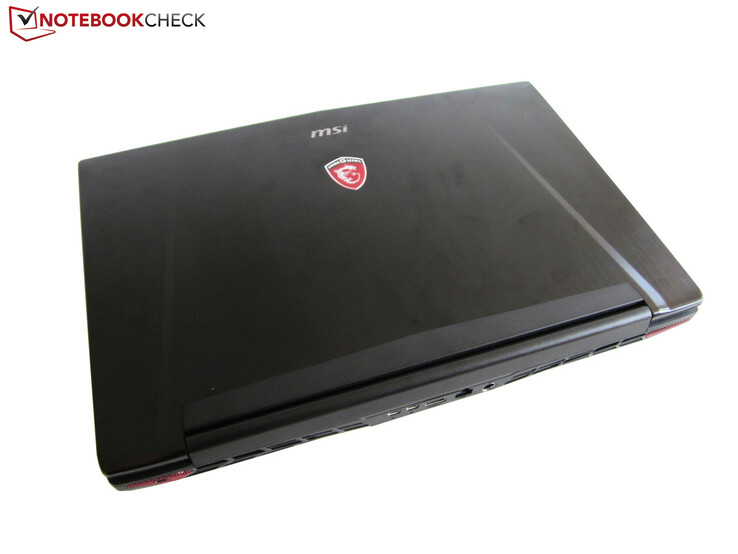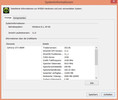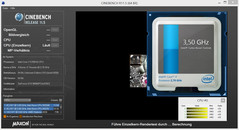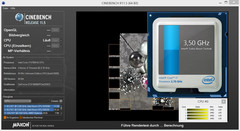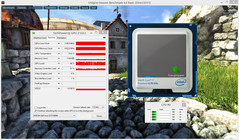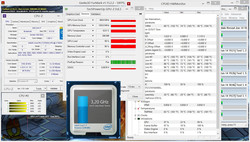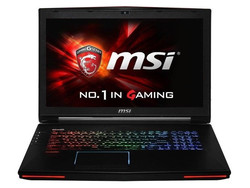MSI GT72 (Broadwell) Notebook Review
For the original German review, see here.
The MSI GT70 has sat on the throne for a long time and is now surpassed by the MSI GT72. In our previous review, we rated the GTX-980M configuration as "Very Good," which is impressive as few models can muster this rating. Thankfully, MSI has not sat on their laurels, basking in their success. The manufacturer has updated the 17-inch gaming laptop: the test model is equipped with a Wide-View panel with True Color technology, which offers far more stable viewing angles and higher color accuracy.
Furthermore, the Core i7-4710HQ of the Intel Haswell generation (22 nm) has been replaced by a Core i7-5700HQ of the Broadwell release (14 nm). The ports have also been refreshed: 4x USB-3.0 and 2x USB-3.1 ports (before it was 6x USB 3.0), which offers even faster speeds for external devices. The package is rounded off with the new sound software. Although the Sound Blaster Cinema 2 engine of the predecessor was quite good, MSI has swapped it out for a program named Nahimic.
The rest of the hardware is typical: for 2,000 Euros (~$2211), the GT72-2QE16SR21BW also offers a 1,000 GB HDD and a RAID 0 mode with two M.2 SSDs (128 + 128 GB). 16 GB DDR3-RAM and a Blu-ray are also included.
Case
We will skip the sections "Case," "Connectivity" and "Input Devices" as these aspects have stayed the same as the previous test model. For more information on these topics, you can find the previous review here.
Display
Most 17-inch laptops used TN technology previously but thanks to IPS panels, the displays have considerably improved. This is definitely a great step forwards as TN displays often have poor viewing angles and a visible blue tinge. The predecessor was equipped with a CMN N173HGE-E11 panel and although it offered great contrast, it scored poorly in the color tests.
| |||||||||||||||||||||||||
Brightness Distribution: 87 %
Center on Battery: 285 cd/m²
Contrast: 633:1 (Black: 0.45 cd/m²)
ΔE ColorChecker Calman: 5.1 | ∀{0.5-29.43 Ø4.78}
ΔE Greyscale Calman: 5.23 | ∀{0.09-98 Ø5}
87% sRGB (Argyll 1.6.3 3D)
57% AdobeRGB 1998 (Argyll 1.6.3 3D)
63.4% AdobeRGB 1998 (Argyll 3D)
86.7% sRGB (Argyll 3D)
68.1% Display P3 (Argyll 3D)
Gamma: 2.32
CCT: 7565 K
The integrated panel of our test model is from LG (LP173WF4-SPF1), which is also found in the "Prestige" model, the PE70. This panel offers better gray levels, RGB balance and color accuracy and saturation, and a calibration will allow the user to get a lot more out of the panel. The pre-installed True-Color software allows the picture to be comfortably adjusted. Whether you are a gamer, designer, office user or a movie enthusiast, you will find the software offers good adjustments to meet your needs. The color coverage is 87% of the sRGB color spectrum (57% AdobeRGB).
| MSI GT72-2QE16SR21BW LP173WF4-SPF1 (LGD0469) | MSI GT70-2QD16SR21 Chi Mei N173HGE-L11 (CM01720) | Schenker XMG U705 LG Philips LP173WF4-SPD1 (LGD046C) | Alienware 17 R2 LG Philips LGD0459 / 173WF4 (Dell P/N: CV69H) | Asus G751JY-T7009H LG Philips LP173WF4-SPD1 (LGD046C) | |
|---|---|---|---|---|---|
| Display | 3% | -4% | -3% | -2% | |
| Display P3 Coverage (%) | 68.1 | 65.4 -4% | 66.3 -3% | 66.6 -2% | 66.4 -2% |
| sRGB Coverage (%) | 86.7 | 93.7 8% | 83.4 -4% | 84.3 -3% | 85.3 -2% |
| AdobeRGB 1998 Coverage (%) | 63.4 | 67.2 6% | 61 -4% | 61.6 -3% | 62.1 -2% |
| Screen | -19% | 16% | 18% | 13% | |
| Brightness middle (cd/m²) | 285 | 325 14% | 333 17% | 331 16% | 329 15% |
| Brightness (cd/m²) | 278 | 312 12% | 317 14% | 307 10% | 326 17% |
| Brightness Distribution (%) | 87 | 80 -8% | 86 -1% | 84 -3% | 93 7% |
| Black Level * (cd/m²) | 0.45 | 0.36 20% | 0.3 33% | 0.3 33% | 0.47 -4% |
| Contrast (:1) | 633 | 903 43% | 1110 75% | 1103 74% | 700 11% |
| Colorchecker dE 2000 * | 5.1 | 11.28 -121% | 5.24 -3% | 4.88 4% | 3.95 23% |
| Colorchecker dE 2000 max. * | 8.01 | ||||
| Greyscale dE 2000 * | 5.23 | 11.62 -122% | 4.33 17% | 3.63 31% | 3.36 36% |
| Gamma | 2.32 95% | 2.33 94% | 2.14 103% | 2.17 101% | 2.46 89% |
| CCT | 7565 86% | 14188 46% | 6437 101% | 6325 103% | 5961 109% |
| Color Space (Percent of AdobeRGB 1998) (%) | 57 | 61 7% | 55 -4% | 55 -4% | 56 -2% |
| Color Space (Percent of sRGB) (%) | 87 | 83.3 -4% | 84.2 -3% | ||
| Total Average (Program / Settings) | -8% /
-13% | 6% /
11% | 8% /
13% | 6% /
9% |
* ... smaller is better
The brightness of the panel is average: 278 cd/m² is too low for outdoor use. The black value should have been better. A value below 0.3 cd/m² would allow the panel to depict dark scenes very well, but our laptop has a value of 0.45 cd/m² which can cause a gray tinge. Overall, the contrast of 663:1 is decent but not great as other panels can offer over 1,000:1.
However, the LG LP173WF4-SPF1 offers relatively good viewing angles. From directly above or below, the picture may be distorted, depending on the lighting and content, but overall it is far more flexible than TN panels. In short: despite these small flaws, the panel impressed us. Sadly, the edges of the panel have strong "bleeding," which, thankfully, is not always noticeable.
Performance
Thanks to the GeForce GTX 980M, the quad-core processors and both SSDs, the test model is in the top-third amongst high-end notebooks. 16 GB DDR3-RAM should ensure the laptop performs well in the future as well.
Processor
The MSI GT72-2QE16SR21BW is one of the first gaming laptops which uses a 14 nm CPU. With a base clock speed of 2.7 GHz, the Core i7-5700HQ reminds us of the Core i7-4800MQ. Although the Haswell brother has a higher Turbo clock speed (max 3.7 GHz), it is only reached by a single core. The advantage of the Broadwell architecture is that the Turbo boost for multi-core is often quite close to the single-core boost. This means the Core i7-5700HQ can offer a constant 3.5 GHz, which is the clock speed of the Core i7-4800MQ. The L3 caches (6 MB) and the TDP value (47 W) are identical.
Thanks to multiple optimizations, the Core i7-5700HQ is faster. The MSI GT72 scores 723 points (vs. 677 points, +7% vs. MSI GT70-20Li716121B) in the multi-CPU test of Cinebench R15. In the single-CPU test, the Core i7-5700HQ is only a little ahead of the Core i7-4800MQ of the workstation with 145 to 140 points. Hyper-Threading offers simultaneous processing of up to 8 threads.
The new graphics chip deserves praise. Intel replaces the HD Graphics 4600 with the 20% stronger HD Graphics 5600, which is still not suitable for modern games. The MSI GT72 only uses the processor IGP if the GPU key is pressed and the computer is restarted.
System Performance
The system performance is very high. As seen from the table below, most gaming laptops land around 6,000 points in PCMark 7. Our laptop scores 5,796 points and provides a smooth Windows experience thanks to the SSDs.
| PCMark 7 Score | 5796 points | |
Help | ||
Storage Devices
MSI combines two M.2 SSDs in RAID 0 mode. A single SATA III drive would be limited at 500 to 550 MB/s whereas both Toshiba models (HG6 THNSNJ128G8NU) in our test model offer sequential read rates above 1,000 MB/s. The sequential read rate is also quite good at 800 MB/s. Smaller files, which are often found in Windows, do not benefit from the RAID setup. Subjectively, we did not perceive a tangible difference in system performance to a system with a single SSD. MSI has installed a lot of programs and tools which affects the system startup time. The buyer does not have to worry about storage space as the manufacturer has included a 1,000 GB HDD. The HGST Travelstar 7K1000 offers decent sequential read and write rates as it operates at 7,200 rpm.
Graphics Card
The Nvidia top model has been out a long time and is well-known so we will focus on some facts. The GeForce GTX 980M offers 1,536 shaders, which is 20% more than the GTX 970M and 50% more than the GTX 965M (1,280 and 1,024 shaders respectively). Similar to Intel Turbo Boost, the Nvidia GPUs can also overclock. The GeForce GTX 980M hits up to 1,127 MHz at load, which is 9% more than the standard speed of 1,038 MHz. The memory interface is quite large at 256-bit and neither the GTX 970M (192-bit) nor the GTX 965M (128-bit) can match it. It is a pity that MSI has chosen the 4 GB VRAM configuration as other notebooks picked the configuration with double that amount. Regardless, as a member of the Maxwell generation, the GTX 980M is produced with the 28 nm process (GM204 chip).
| 3DMark 11 Performance | 11325 points | |
| 3DMark Ice Storm Standard Score | 125067 points | |
| 3DMark Cloud Gate Standard Score | 24043 points | |
| 3DMark Fire Strike Score | 8429 points | |
Help | ||
In the benchmark course, our test model fights fiercely with the rest of the competition: 8,429 points in the Fire-Strike test of the 3DMark benchmark is quite close to the score of the strongest competitor, the Asus G751JY (8,338 points). Laptops based on a GTX 970M are about 20 to 25% slower. Thanks to the MXM build, the graphics card can be swapped out (unlike the CPU which is soldered on-board).
| 3DMark - 1920x1080 Fire Strike Score (sort by value) | |
| MSI GT72-2QE16SR21BW | |
| MSI GT70-2QD16SR21 | |
| Schenker XMG U705 | |
| Alienware 17 R2 | |
| Asus G751JY-T7009H | |
| 3DMark 11 - 1280x720 Performance (sort by value) | |
| MSI GT72-2QE16SR21BW | |
| MSI GT70-2QD16SR21 | |
| Schenker XMG U705 | |
| Alienware 17 R2 | |
| Asus G751JY-T7009H | |
Gaming Performance
The GeForce GTX 980M can run almost any game fluidly at max details and the FHD resolution (1920x1080 pixels). The racing game, Dirt Rally, and multiplayer hit, Evolve, ran smoothly with "Ultra" settings. Truly demanding games, like Assassin's Creed Unity or The Witcher 3 can cause the notebook to stutter at such high settings.
| low | med. | high | ultra | |
|---|---|---|---|---|
| Assassin's Creed Unity (2014) | 106.4 | 89 | 58.4 | 32.7 |
| Evolve (2015) | 153.7 | 140.4 | 85.6 | 76.3 |
| Dirt Rally (2015) | 295.4 | 151.4 | 111.4 | 68.7 |
| The Witcher 3 (2015) | 172.4 | 101.4 | 61.3 | 33.8 |
| The Witcher 3 - 1920x1080 Ultra Graphics & Postprocessing (HBAO+) (sort by value) | |
| MSI GT72-2QE16SR21BW | |
| Schenker W504 | |
| Schenker W504 | |
| Dirt Rally - 1920x1080 Ultra Preset AA:4x MS (sort by value) | |
| MSI GT72-2QE16SR21BW | |
| Schenker W504 | |
| Schenker W504 | |
| Evolve - 1920x1080 Very High Graphics Quality AA:1TX SM (sort by value) | |
| MSI GT72-2QE16SR21BW | |
| Schenker XMG U705 | |
| Schenker W504 | |
| Schenker W504 | |
| Assassin's Creed Unity - 1920x1080 Ultra High Graphics Quality AA:4x MS (sort by value) | |
| MSI GT72-2QE16SR21BW | |
| Schenker XMG U705 | |
| Asus G751JY-T7009H | |
Emissions
As few users will regularly switch over to the Intel IGP, we ran all measurements on the Nvidia GPU.
System Noise
While idle, the emissions are typical for a gaming notebook at 33-34 dB. Although these levels are audible, they are not disturbing. The HDD is droned out, especially when the Nvidia GPU is active. At load, the GT72 is surprisingly quiet. While most other high-end notebooks hit above 40 dB (even 45 dB) in 3DMark06, the MSI test model is relatively quiet at 39 dB. The Asus G751JY and the MSI GT70 are the only models which can be quieter at 37 dB. In the stress test, the model performs quite well: a max emission of 46 dB is reasonable. In comparison, the Alienware 17 R2 drones quite loudly at 52 dB.
Noise level
| Idle |
| 33.2 / 33.6 / 34.4 dB(A) |
| DVD |
| 36.6 / dB(A) |
| Load |
| 39.3 / 46.4 dB(A) |
 | ||
30 dB silent 40 dB(A) audible 50 dB(A) loud |
||
min: | ||
| MSI GT72-2QE16SR21BW GeForce GTX 980M, 5700HQ | MSI GT70-2QD16SR21 GeForce GTX 970M, 4710MQ | Schenker XMG U705 GeForce GTX 970M, 4790 | Alienware 17 R2 GeForce GTX 980M, 4980HQ | Asus G751JY-T7009H GeForce GTX 980M, 4710HQ | |
|---|---|---|---|---|---|
| Noise | -3% | 2% | -1% | 1% | |
| Idle Minimum * (dB) | 33.2 | 33.8 -2% | 29.2 12% | 29.4 11% | 33.6 -1% |
| Idle Average * (dB) | 33.6 | 35.2 -5% | 32.6 3% | 30.8 8% | 34.8 -4% |
| Idle Maximum * (dB) | 34.4 | 35.6 -3% | 33.2 3% | 35 -2% | 35.2 -2% |
| Load Average * (dB) | 39.3 | 36.6 7% | 44.2 -12% | 43.4 -10% | 36.8 6% |
| Load Maximum * (dB) | 46.4 | 53 -14% | 45.4 2% | 51.6 -11% | 43.8 6% |
* ... smaller is better
Temperature
The temperatures are acceptable. On average, the laptop is 30 °C hot while idle and hits 40 °C at full load. Although the chassis can hit levels above 50 °C, it only happens near the fan vent. The hand-rest regions never get uncomfortably warm. After an hour of stress testing with Furmark and Prime, the laptop reached a mere 34 °C. The hardware does not suffer from obnoxiously high temperatures and both the CPU and GPU can stay below the 90 °C. The GT72 has to accept a little criticism due to slight GPU throttling: in Furmark, the core clock speed drops to 860 MHz. In a test with the Unigine Heaven 4.0 benchmark, we did not notice any throttling. Furthermore, we did not note any CPU throttling at full load in the Unigine Heaven benchmark, as even at 100% load, the Core i7-5700HQ operates at 3.0 GHz.
(±) The maximum temperature on the upper side is 45 °C / 113 F, compared to the average of 40.4 °C / 105 F, ranging from 21.2 to 68.8 °C for the class Gaming.
(-) The bottom heats up to a maximum of 54.9 °C / 131 F, compared to the average of 43.3 °C / 110 F
(+) In idle usage, the average temperature for the upper side is 30.6 °C / 87 F, compared to the device average of 33.9 °C / 93 F.
(+) The palmrests and touchpad are reaching skin temperature as a maximum (33.7 °C / 92.7 F) and are therefore not hot.
(-) The average temperature of the palmrest area of similar devices was 28.9 °C / 84 F (-4.8 °C / -8.7 F).
| MSI GT72-2QE16SR21BW GeForce GTX 980M, 5700HQ | MSI GT70-2QD16SR21 GeForce GTX 970M, 4710MQ | Schenker XMG U705 GeForce GTX 970M, 4790 | Alienware 17 R2 GeForce GTX 980M, 4980HQ | Asus G751JY-T7009H GeForce GTX 980M, 4710HQ | |
|---|---|---|---|---|---|
| Heat | 17% | -12% | 1% | 12% | |
| Maximum Upper Side * (°C) | 45 | 46.8 -4% | 46.6 -4% | 50.8 -13% | 43.3 4% |
| Maximum Bottom * (°C) | 54.9 | 50.2 9% | 55 -0% | 48.7 11% | 48 13% |
| Idle Upper Side * (°C) | 32.4 | 22.9 29% | 38.8 -20% | 30.9 5% | 27.7 15% |
| Idle Bottom * (°C) | 32.4 | 21.8 33% | 40 -23% | 31.7 2% | 27.9 14% |
* ... smaller is better
Speakers
Whether Sound Blaster Cinema 2 or Nahimic, the sound system of this high-end notebook produces good sound output. Thanks to multiple optimizations and modes (Music, Movie, Game), the audio output is pleasantly clear, strong and balanced. In comparison, most competitors sound dull or, even worse, muddled. Furthermore, the system has a high max volume, which allows the user to sit back comfortably without sacrificing audio quality. All-in-all, no other manufacturer can match the 2.1 system of Dynaudio.
Energy Management
Power Consumption
As the notebook lacks Optimus, the idle power consumption is much higher than other GTX 980M notebooks. The Alienware 17 R2 consumes 8.9 to 26.6 W whereas our model requires 28.0 to 35.7 W. The Asus G751JY, which does not require graphics-switching technology, consumes 22.0 to 32.6 W (slightly less). At load, the GT72 does not have to hide itself from the competition: the test model consumes 101 W in the first scene of 3DMark06, which is trumped by far by the Alienware 17 R2 with its consumption of 124 W (Core i7-4980HQ). The Asus model is a little more conservative than our model (~93 W). The max power consumption cannot be directly compared as the notebooks throttle differently. 212 W is the max consumption of the GT72, but this is acceptable as the power adapter can supply up to 230 W. The Intel Broadwell architecture barely makes a difference in the power consumption, when compared to the consumption values of the Haswell predecessor. The higher idle consumption of the new GT72 could be due to the panel (IPS vs. TN).
| Off / Standby | |
| Idle | |
| Load |
|
Key:
min: | |
| MSI GT72-2QE16SR21BW GeForce GTX 980M, 5700HQ | MSI GT70-2QD16SR21 GeForce GTX 970M, 4710MQ | Schenker XMG U705 GeForce GTX 970M, 4790 | Alienware 17 R2 GeForce GTX 980M, 4980HQ | Asus G751JY-T7009H GeForce GTX 980M, 4710HQ | |
|---|---|---|---|---|---|
| Power Consumption | 25% | -20% | 29% | 11% | |
| Idle Minimum * (Watt) | 28 | 14.2 49% | 38.3 -37% | 8.9 68% | 22 21% |
| Idle Average * (Watt) | 33.3 | 21.5 35% | 38.8 -17% | 16 52% | 27 19% |
| Idle Maximum * (Watt) | 35.7 | 26.2 27% | 44.4 -24% | 26.6 25% | 32.6 9% |
| Load Average * (Watt) | 101 | 97.4 4% | 119.3 -18% | 124 -23% | 93.3 8% |
| Load Maximum * (Watt) | 212.2 | 186.1 12% | 221.4 -4% | 165.8 22% | 212.8 -0% |
* ... smaller is better
Battery Life
If you wish to use the GT72 for simple tasks while on battery, we recommend switching over to the HD Graphics 5600 IGP with the GPU button, as otherwise the 17-inch model will shut down after 3 hours and 45 minutes. In Intel mode, the predecessor achieves up to 6.5 hours. Suboptimal: the 9-cell battery (87 Wh, 7,800 mAh) is not accessible even after taking off the maintenance flap.
| MSI GT72-2QE16SR21BW GeForce GTX 980M, 5700HQ | MSI GT70-2QD16SR21 GeForce GTX 970M, 4710MQ | Schenker XMG U705 GeForce GTX 970M, 4790 | Alienware 17 R2 GeForce GTX 980M, 4980HQ | Asus G751JY-T7009H GeForce GTX 980M, 4710HQ | |
|---|---|---|---|---|---|
| Battery runtime | 35% | -16% | 121% | 9% | |
| Reader / Idle (h) | 3.8 | 7 84% | 2.3 -39% | 12.2 221% | 4.5 18% |
| Load (h) | 1.4 | 1.2 -14% | 1.5 7% | 1.7 21% | 1.4 0% |
Pros
Cons
Verdict
MSI tunes the GT72 in the right spots. We love the USB 3.1 ports as these will keep the model relative in the future. The IPS panel is a step up for picture quality. The rest of the updates are not as large: in comparison to the Haswell generation, the Broadwell processor is merely a little faster.
The GT72 is quite similar to the predecessor in other aspects. The maintenance options are quite good, if you disregard the inaccessible battery and soldered CPU. The input devices and emissions are quite good. The speakers provide great sound, which is rare for notebooks. The great performance is another plus, although we would have appreciated a PCI-Express SSD. The manual switch between graphics chips and heavy case (3.7 kg) are a matter of taste.
Due to various minor display flaws, the MSI GT72 cannot receive a high rating like the Asus G751JY (89%). We found massive display "bleeding," a creaky screen cover and an optical drive which juts out of the case. These flaws are not acceptable in a laptop worth 2,000 Euros (~$2211). A better WLAN reception and 8 GB VRAM would have been nice as well. Furthermore, the display content sometimes "burns" into the screen (the predecessor is similar) which is a flaw likely to dissuade some gamers from the purchase. Overall though, the 17-inch laptop is worth a look.
MSI GT72-2QE16SR21BW
- 06/17/2015 v4 (old)
Florian Glaser











